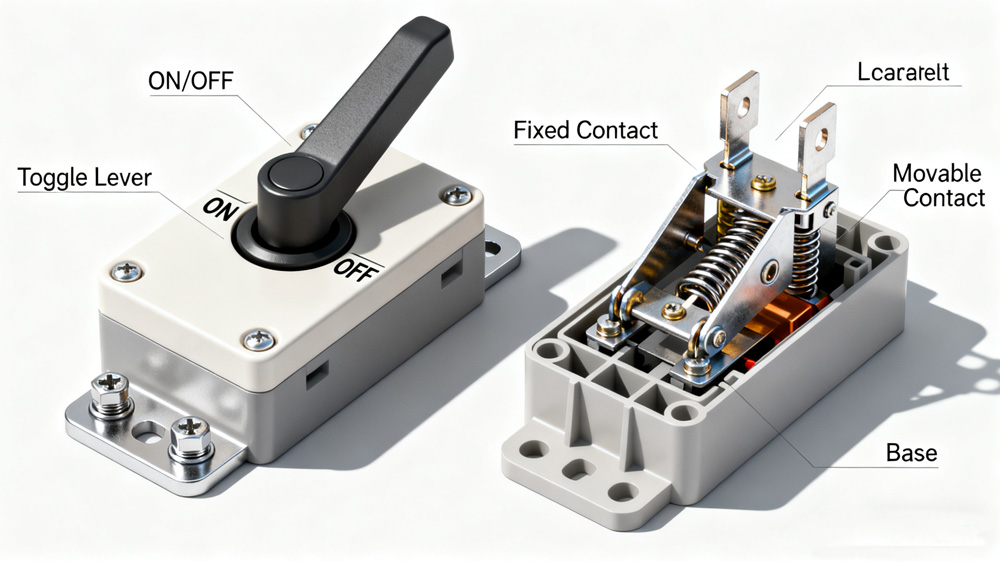Toggle switches are one of the most common and versatile types of switches used in both industrial and consumer applications. These simple yet effective devices allow users to control electrical circuits with ease, providing a clear on/off function through a lever or handle that moves between positions.
Getting familiar with how toggle switches work and where they are used can benefit anyone working with electronics, automotive systems, industrial equipment, or even home projects.

What Are Toggle Switches
A toggle switch is a manually operated electrical switch that controls the flow of current in a circuit. Its defining feature is the lever or handle that moves to change the state of the circuit, either allowing electricity to flow or interrupting it.
Unlike other switches, toggle switches offer a tactile response and a visual indication of the circuit’s status. They are widely appreciated for their simplicity, reliability, and durability, making them a staple component across various applications.
How Does a Toggle Switch Work
The operation of a toggle switch relies on mechanical contacts inside the switch body. When the lever is flipped, it either connects or disconnects the internal contacts, completing or breaking the circuit.
For example, a single-pole, single-throw (SPST) toggle switch has two positions: on and off. Moving the lever completes the circuit, allowing electricity to pass through, or breaks it, stopping the current. More advanced designs, such as double-pole, double-throw (DPDT) switches, can control multiple circuits simultaneously, providing greater versatility for complex applications.
What Are Toggle Switches Used For
Toggle switches have a wide range of uses across multiple industries. In automotive applications, they are commonly used for headlights, auxiliary lights, or other electrical accessories. Industrial machinery often relies on toggle switches to start motors, control conveyor belts, or operate emergency stop mechanisms.
In consumer electronics, toggle switches provide simple on/off control for devices, equipment, and appliances. Their straightforward design and reliable operation make them suitable for almost any scenario requiring a clear and durable switch function.
Pros & Cons
Pros
Toggle switches come with several advantages. They are durable and can withstand repeated use, offering long-lasting performance. They provide a clear tactile and visual indication of the circuit’s status, making them user-friendly.
Toggle switches are often capable of handling higher current loads compared to other types of switches, which adds to their reliability in demanding applications.
Cons
On the downside, toggle switches can be larger than other switch types, which may limit their use in compact electronic devices. Additionally, while they are robust, they may not offer the aesthetic design options of modern membrane or push-button switches.
Discover our Toggle Ranges
For those looking to explore toggle switch options, a variety of ranges are available to meet different needs. Our toggle switches come in multiple configurations, including SPST, SPDT, DPST, and DPDT, providing flexibility in controlling single or multiple circuits.
They are built from high-quality materials to ensure durability and consistent performance. Whether you need a miniature toggle switch for electronics or a heavy-duty industrial toggle switch, there are options designed to meet your requirements.
Different Types of Toggle Switches
Toggle switches come in several types, each designed for specific applications. Single-pole, single-throw (SPST) switches provide basic on/off functionality for simple circuits. Single-pole, double-throw (SPDT) switches allow one input to connect to one of two outputs, offering more control options.
Double-pole, single-throw (DPST) switches can control two circuits simultaneously with a single toggle action. Double-pole, double-throw (DPDT) switches are the most versatile, allowing for complex wiring and circuit control. Choosing the right type depends on the number of circuits you need to control and the specific application requirements.
How to Choose the Right Toggle Switch for Your Needs
Selecting the correct toggle switch involves considering several factors. First, determine the electrical load the switch needs to handle, including voltage and current ratings. Next, consider the type of circuit control required, such as SPST, SPDT, DPST, or DPDT.
Environmental conditions, including exposure to moisture, dust, or extreme temperatures, should also influence your choice, as some switches are rated for rugged conditions. Additionally, think about the physical size and mounting requirements to ensure compatibility with your device or panel.
How to Install Toggle Switches Safely and Correctly
Installing a toggle switch safely requires careful attention to wiring and mounting. Always ensure the power is turned off before beginning installation to prevent electrical shock. Follow the manufacturer’s wiring diagram to connect the switch correctly, ensuring that terminals match the intended circuit configuration.
Use proper tools and secure the switch firmly in place to avoid movement that could compromise connections. After installation, test the switch by toggling it on and off to verify that the circuit functions as intended. For more complex applications, consulting a professional electrician is recommended to ensure compliance with safety standards.
Conclusion
Toggle switches are widely used in many electrical applications. Their simple design and durability make them a reliable choice for automotive, industrial, and consumer electronics. Understanding their operation and proper installation helps ensure safe and effective performance.
 +86 138-6870-3133
+86 138-6870-3133 sales@lanzmfg.com
sales@lanzmfg.com EN
EN CN
CN Search
Search